
Roots
A quiet understanding often settles upon us when we consider the delicate nature of our hair, especially strands that coil and curve with unique artistry. We sense, without always articulating, that these natural formations demand a particular kind of guardianship. This recognition deepens as we acknowledge the invisible nightly struggles our hair endures, a silent battle against friction and the subtle, yet persistent, draining of its very life force. It is in this quiet recognition that the purpose of the bonnet, a seemingly simple textile, begins to reveal itself, not merely as an accessory, but as a sentinel for our hair’s well-being.
To truly appreciate the bonnet’s protective capacity, one must first consider the inherent characteristics of textured hair. Unlike straight hair, which typically possesses a round cross-section, curly and coily strands exhibit an elliptical or even flat shape. This structural difference means that the cuticle, the outermost protective layer of the hair shaft, does not lie as smoothly or uniformly.
Instead, these cuticles are often more raised, creating a surface that is naturally more prone to snagging and breakage when subjected to external forces. This unique architecture also means that natural oils produced by the scalp find it more challenging to travel down the length of the hair shaft, leaving the ends particularly vulnerable to dryness.
Textured hair, with its unique structural characteristics, possesses an inherent vulnerability to friction and moisture loss, making nighttime protection a vital aspect of its care.
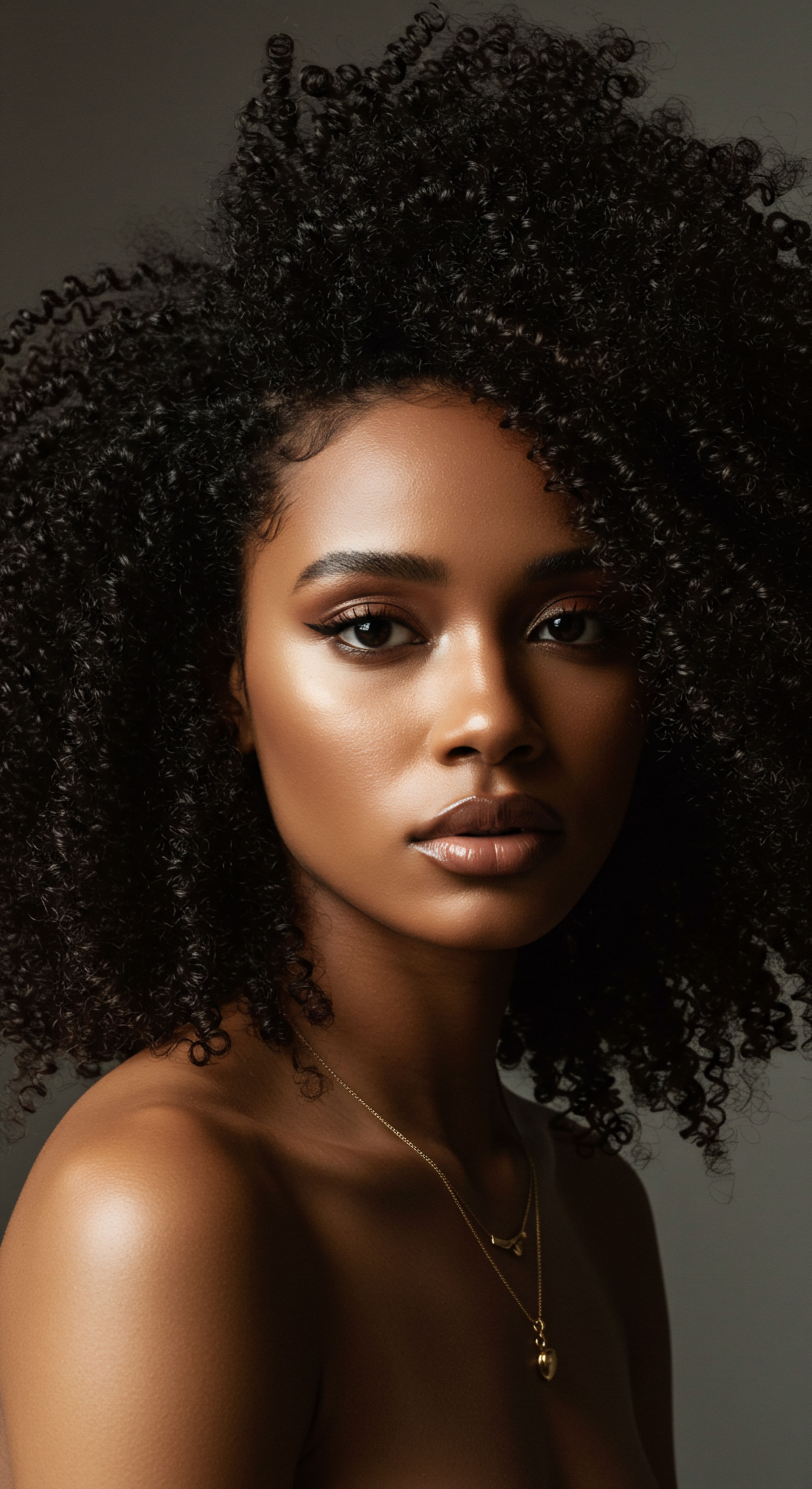
Hair Fiber and Its Fragility
The very composition of hair, primarily a protein called Keratin, dictates much of its behavior and resilience. In textured hair, the twists and turns within the fiber create points of structural weakness. These bends act as potential fracture zones, making the strands more susceptible to damage from mechanical stress.
When hair rubs against rough surfaces, like a cotton pillowcase, these raised cuticles catch and lift, leading to frizz, tangles, and ultimately, breakage. This mechanical wear compromises the hair’s integrity, diminishing its natural luster and strength over time.
Beyond mechanical fragility, textured hair often experiences a greater challenge in retaining moisture. Its porous nature means that while it readily absorbs water, it also loses it quickly to the surrounding environment. This susceptibility to dehydration is particularly pronounced overnight, as the hair is exposed to dry air and absorbent fabrics. A consistent routine of moisture retention becomes paramount for these hair types, not merely for softness, but for maintaining the elasticity that prevents snapping and splitting.

How Does Hair Structure Influence Its Nightly Needs?
The architectural distinctions of textured hair dictate a specific approach to nighttime care. Imagine the delicate curves of a coiled strand. Each curve is a point where the hair fiber might be more exposed or where the cuticle layers might be slightly lifted. When these strands encounter the typical friction of a pillow, especially one made of cotton, the consequences are immediate and cumulative.
Cotton, with its absorbent and relatively coarse fibers, acts like a sponge, drawing moisture from the hair and creating microscopic snags that roughen the cuticle. This action can disrupt the hair’s natural curl pattern, leading to flattened, frizzy, or matted hair upon waking.
Consider the long hours spent in sleep, often eight or more. During this extended period, the hair is in constant, albeit subtle, contact with bedding. Without a protective barrier, the repeated rubbing and pressing can lead to significant mechanical abrasion.
This continuous stress on the hair shaft contributes to weakened strands, split ends, and reduced definition. For individuals with textured hair, whose strands are already predisposed to dryness and breakage, neglecting nighttime protection can undermine even the most diligent daytime care regimen.
The solution lies in creating a smooth, low-friction environment that allows hair to glide rather than catch, and that safeguards its moisture. This foundational understanding sets the stage for appreciating the practical and profound role of bonnets in preserving the health and vibrancy of textured hair.
- Hair Anatomy ❉ The elliptical cross-section and raised cuticles of textured hair increase its vulnerability to friction and breakage.
- Moisture Loss ❉ Textured hair’s porous nature makes it prone to rapid moisture evaporation, especially overnight.
- Mechanical Stress ❉ Friction from bedding can cause tangles, frizz, and damage to the delicate hair shaft.
| Component Cuticle |
| Primary Makeup Overlapping keratin cells |
| Role in Hair Health Outermost protective layer, shields inner cortex from damage. |
| Component Cortex |
| Primary Makeup Keratin protein bundles |
| Role in Hair Health Determines hair's strength, elasticity, and color. |
| Component Medulla |
| Primary Makeup Central core (sometimes absent) |
| Role in Hair Health Contributes to hair's thickness and resilience. |
| Component Maintaining the integrity of these components is vital for healthy hair. |
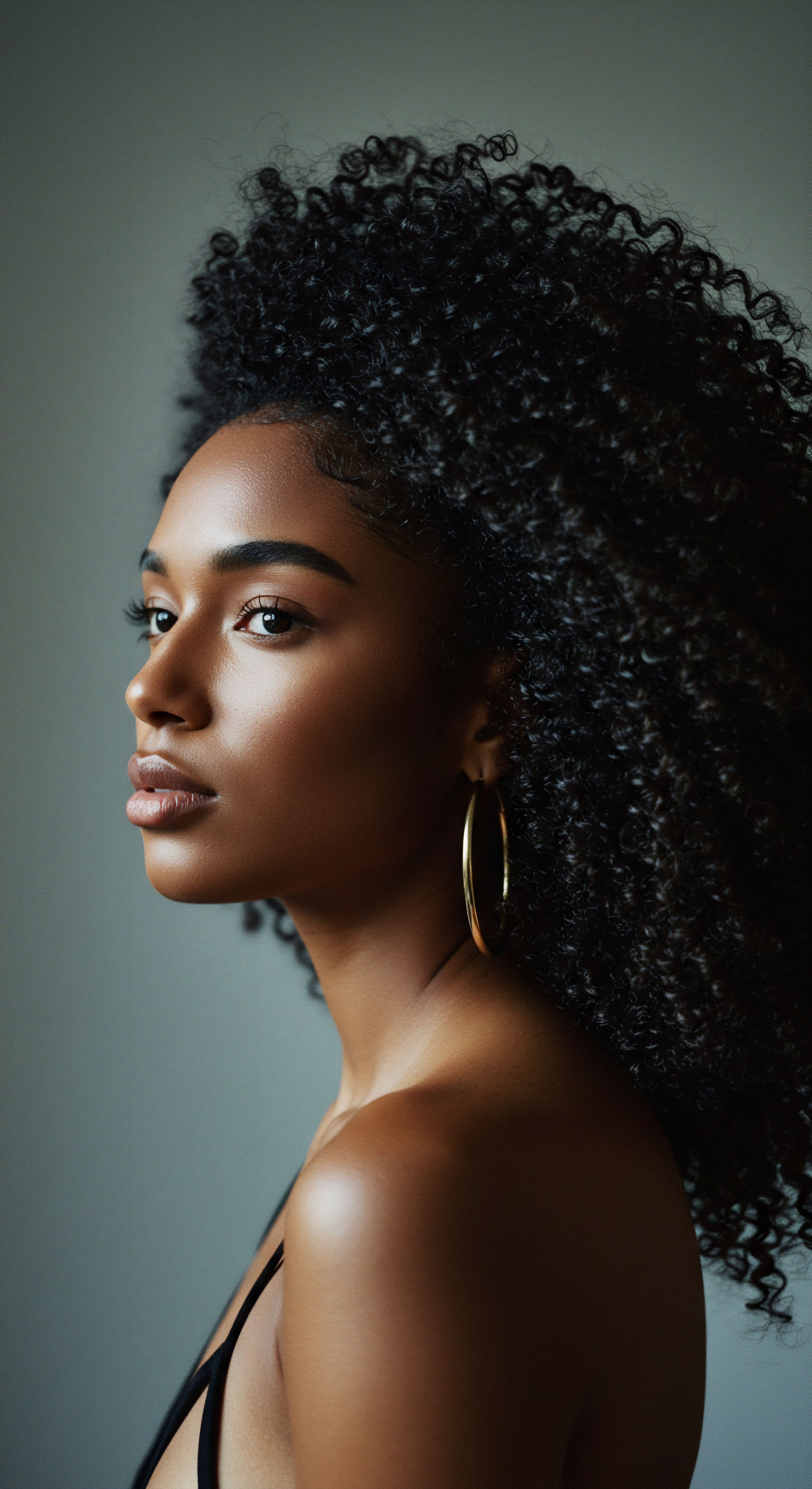
Ritual
Stepping from the quiet contemplation of hair’s intrinsic nature, we arrive at the practical realm of its care, where daily actions shape its resilience. Here, the bonnet steps forward, not as a mere adornment, but as a silent, diligent partner in a nightly ritual of preservation. It represents a conscious choice to shield delicate strands from the environmental challenges of sleep, offering a gentle embrace that speaks to a deeper respect for hair’s well-being. This section aims to provide practical wisdom, guiding you through the methods and choices that make the bonnet an indispensable tool in textured hair care.
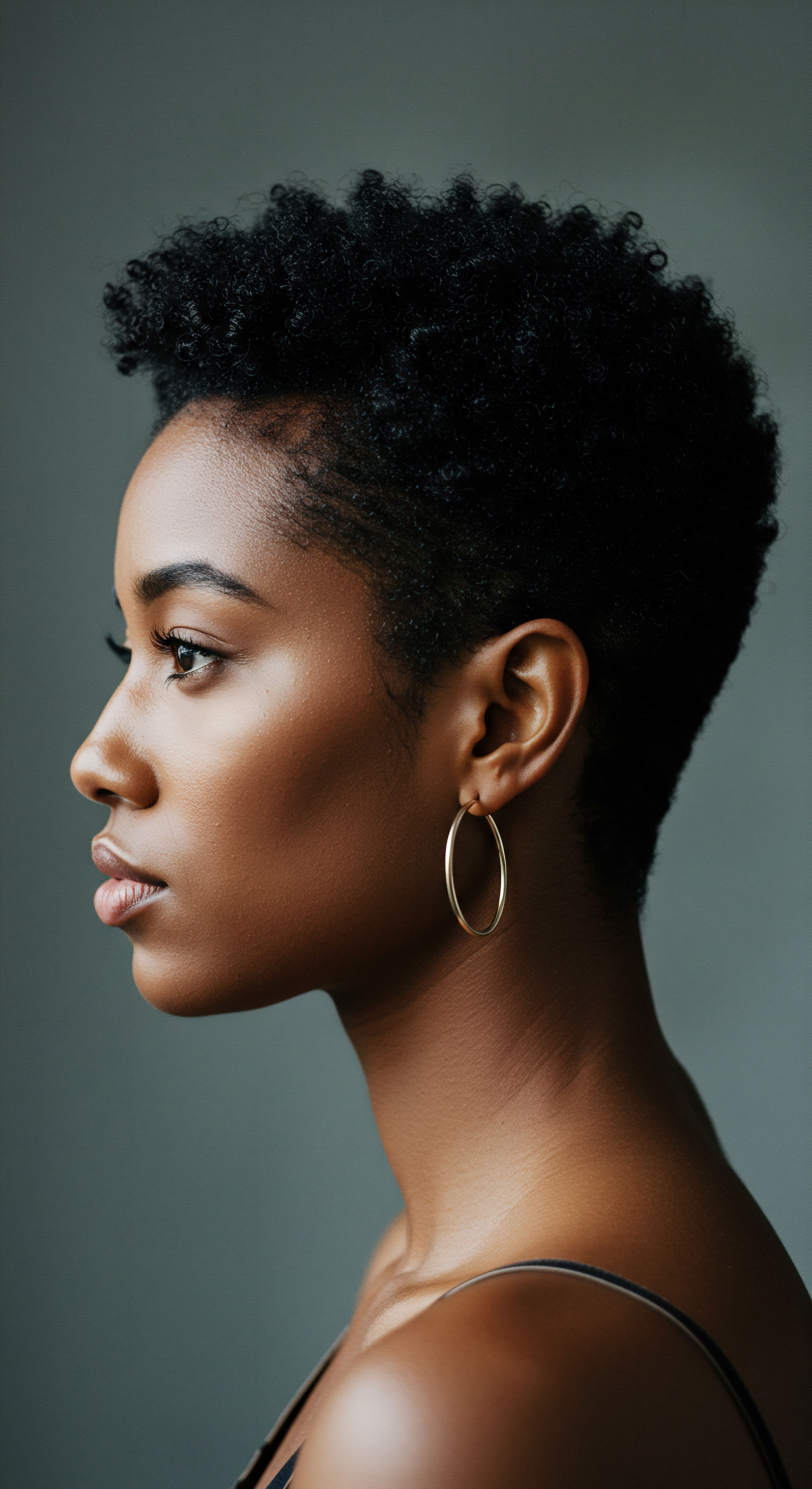
The Bonnet as a Protective Cocoon
At its heart, the bonnet serves as a protective enclosure for the hair during sleep. When one rests, especially on conventional cotton pillowcases, the hair experiences significant friction. Cotton fibers, though soft to the touch, possess a rougher surface at a microscopic level compared to silk or satin. This roughness creates drag against the hair cuticle, leading to frizz, tangles, and ultimately, breakage.
A bonnet acts as a smooth, non-abrasive barrier, allowing the hair to glide freely within its confines, thus minimizing mechanical stress. This simple act of separation from harsh surfaces makes a considerable difference in maintaining hair’s structural integrity overnight.
Beyond friction reduction, bonnets play a significant role in moisture retention. Textured hair is particularly susceptible to moisture loss due to its raised cuticles and coil patterns, which hinder the even distribution of natural oils. Cotton, being a highly absorbent material, can draw moisture directly from the hair, leaving it dry and brittle. Silk and satin, the preferred materials for bonnets, are far less absorbent.
They allow the hair to retain its natural oils and any applied conditioning products, thereby preserving its hydration levels throughout the night. This consistent moisture balance is crucial for maintaining elasticity, softness, and curl definition, reducing the need for extensive restyling or remoisturizing each morning.
A bonnet provides a smooth, non-absorbent environment, safeguarding hair from friction and moisture loss, thereby preserving its natural hydration and curl pattern.

Choosing the Right Bonnet Material
The effectiveness of a bonnet hinges significantly on the material from which it is crafted. While many options exist, silk and satin stand out as the most beneficial for hair health.
- Silk ❉ A natural protein fiber, silk possesses a remarkably smooth surface due to its protein composition, specifically fibroin. This natural smoothness yields a very low friction coefficient, meaning hair glides effortlessly across it. Silk also has limited moisture absorption, around 11% of its weight, which helps hair retain its natural hydration. Clinical testing has shown that silk bonnets can reduce hair breakage by up to 43% compared to cotton coverings over an eight-week period. This makes silk a superior choice for those seeking maximum protection and moisture preservation.
- Satin ❉ Often made from synthetic materials like polyester, satin refers to a type of weave that creates a smooth, glossy surface. While not possessing the same natural protein benefits as silk, good quality satin still offers significantly less friction than cotton and does not absorb moisture from hair as readily. It presents a more accessible alternative that still delivers considerable benefits in terms of reducing frizz, tangles, and breakage.
The choice between silk and satin often comes down to personal preference and budget, but both offer substantial advantages over cotton. A study by TRI Princeton developed a test to measure friction between hair and different fabrics, finding that luxury silk was the smoothest material. Velvet, despite its soft feel, registered 37.4% more friction than cotton and a notable 76.5% more than satin, underscoring the importance of specific material properties beyond mere tactile softness.
| Material Type Silk |
| Friction Level Very Low |
| Moisture Absorption Low (approx. 11%) |
| Primary Benefit Maximal friction reduction, optimal moisture retention. |
| Material Type Satin (Polyester) |
| Friction Level Low to Moderate |
| Moisture Absorption Moderate |
| Primary Benefit Significant friction reduction, good moisture retention. |
| Material Type Cotton |
| Friction Level High |
| Moisture Absorption High (up to 25%) |
| Primary Benefit High friction, dehydrates hair. |
| Material Type Selecting silk or satin can significantly improve hair health by reducing friction and preserving hydration. |
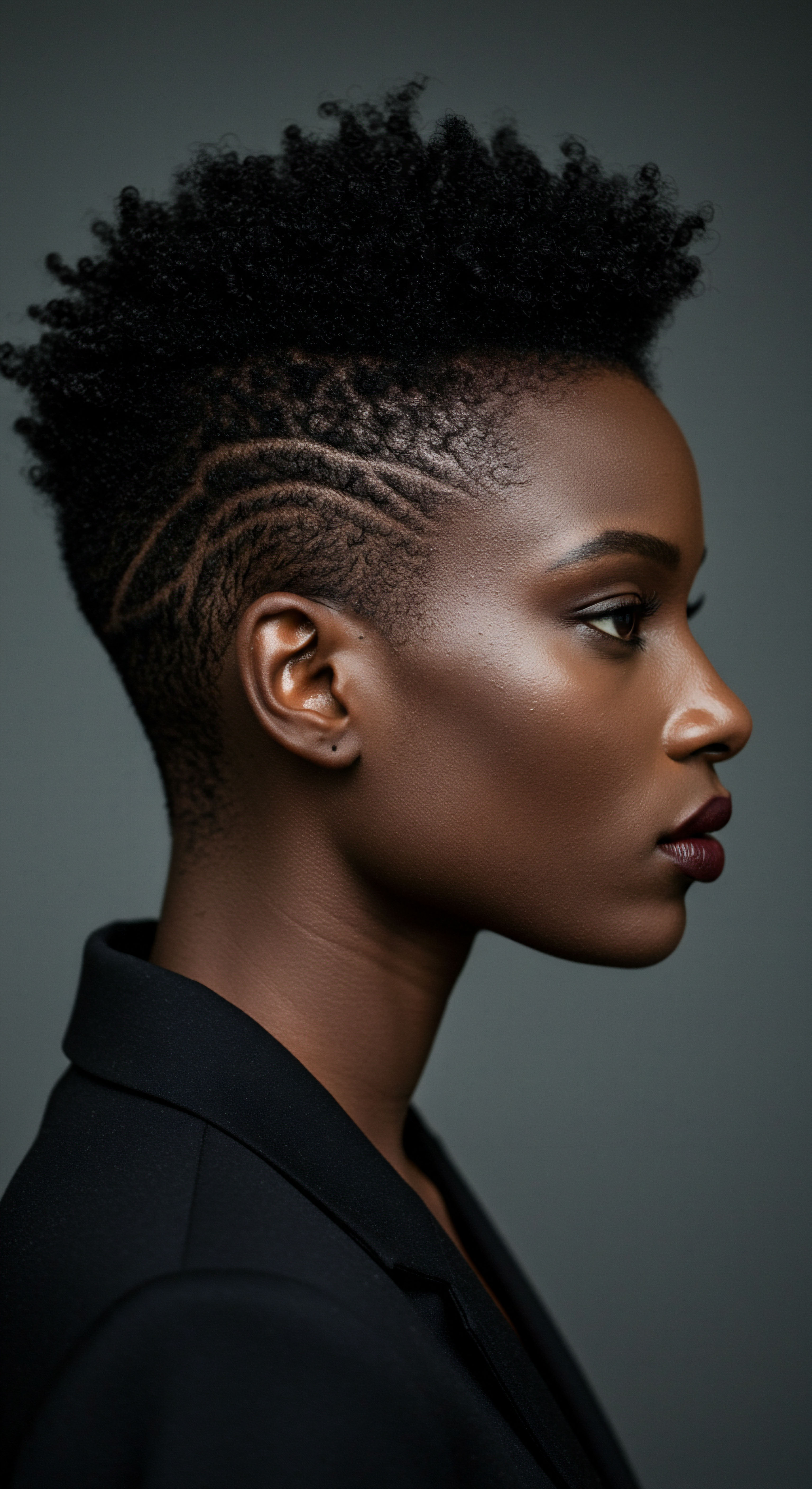
How Does a Bonnet Prevent Hair Damage While You Sleep?
The mechanisms through which a bonnet shields hair during sleep are multifaceted, addressing both mechanical and environmental stressors. Firstly, the smooth surface of silk or satin minimizes the physical abrasion that occurs when hair rubs against rougher fabrics. Each toss and turn during the night, which can be frequent and unconscious, causes hair strands to drag across the pillowcase.
This constant rubbing creates micro-tears in the hair’s delicate cuticle layer, leading to raised cuticles, frizz, and eventual breakage. A bonnet acts as a buffer, allowing hair to glide smoothly, preserving the cuticle’s integrity and thus the hair’s natural smoothness and shine.
Secondly, bonnets create a microclimate around the hair, helping to seal in moisture. Air, especially dry indoor air, can rapidly strip hair of its hydration overnight. Cotton, with its high absorbency, compounds this issue by actively drawing out moisture. Silk and satin, by contrast, are less absorbent and act as a gentle barrier, keeping the hair’s natural oils and any applied leave-in conditioners or serums where they belong – on the hair.
This consistent hydration is particularly important for textured hair, which is inherently prone to dryness and requires higher moisture levels for elasticity and definition. By preventing moisture loss, bonnets help maintain curl patterns, reduce frizz, and keep hair soft and pliable, minimizing the need for daily manipulation and re-wetting, which can further stress the strands.
Finally, bonnets help to keep hairstyles intact. Whether it’s a freshly set style, braids, twists, or simply defined curls, a bonnet can help preserve the style’s shape and definition, reducing tangling and matting that often occur during sleep. This preservation means less time spent restyling in the morning, which in turn reduces overall manipulation and the potential for damage from brushes, combs, or heat styling. The quiet act of donning a bonnet before bed thus becomes a powerful preventative measure, contributing significantly to the long-term health and vitality of textured hair.

Relay
Moving beyond the immediate physical benefits, we find the bonnet occupying a space far richer and more resonant than mere utility. Its presence, particularly within Black and mixed-race communities, speaks volumes about identity, resistance, and a profound connection to heritage. This section seeks to understand the deeper currents that position the bonnet not simply as a tool for hair care, but as a cultural artifact, a symbol laden with stories, struggles, and triumphs that extend across generations and geographies. How does a simple piece of fabric come to hold such weight, and what cultural narratives do bonnets carry within their soft folds?

Bonnets Beyond Utility a Cultural Beacon
The journey of head coverings within the African diaspora is a compelling one, deeply intertwined with historical events and social shifts. Originally, headwraps in various African cultures held diverse meanings, signifying marital status, social standing, wealth, or spiritual beliefs. They were expressions of identity and beauty, often crafted from vibrant, patterned fabrics. However, with the transatlantic slave trade, the meaning of head coverings shifted dramatically.
Enslaved African women were often forced to wear head coverings, not as a mark of status, but as a means of control and to signify their supposed inferiority. Laws, such as the Tignon Laws in 18th-century Louisiana, explicitly mandated that free women of color cover their hair to undermine their perceived allure and reinforce social hierarchies.
Yet, in a powerful act of defiance, these women reclaimed the headwrap. They transformed a symbol of oppression into one of resistance, adorning their coverings with luxurious fabrics, intricate ties, and vibrant colors, asserting their dignity and cultural pride even under duress. This historical context is paramount; it imbues the modern bonnet with a profound legacy.
While the contemporary bonnet’s primary function is hair protection, its very existence in these communities carries the echoes of this historical reclamation. It represents a continuity of practice, a quiet act of self-preservation that extends beyond the physical realm into the psychological and cultural.
The bonnet transcends its practical function, standing as a quiet testament to a rich history of resilience and identity reclamation within the African diaspora.

The Psychology of Hair and Identity
Hair, across cultures, is rarely just hair. It is a powerful symbol of self, identity, and group affiliation. For Black women, hair holds a particularly deep significance, often intertwined with personal self-esteem and broader societal perceptions.
Historically, Black hair has been subjected to Eurocentric beauty standards, leading to pressure to straighten or alter natural textures to conform. This pressure can have significant psychological impacts, affecting self-worth and confidence.
In this context, the bonnet plays a subtle yet significant role in psychological well-being. By providing a reliable means of protective styling, it allows individuals to maintain the health of their natural hair, reducing the need for damaging heat or chemical treatments often used to achieve straightened styles. This ability to care for and preserve one’s natural texture contributes to a greater sense of self-acceptance and pride in one’s inherent beauty. The act of wearing a bonnet can be a personal statement of self-care, a daily affirmation of valuing one’s natural hair, irrespective of external pressures.
Furthermore, the bonnet, as a visible accessory in certain contexts, can serve as a quiet signifier of shared cultural understanding and community. When one sees another wearing a bonnet, particularly in spaces outside the home, it can spark a moment of recognition, a silent nod to a shared heritage and a common commitment to hair health and cultural expression. This shared experience reinforces a sense of belonging and collective identity.
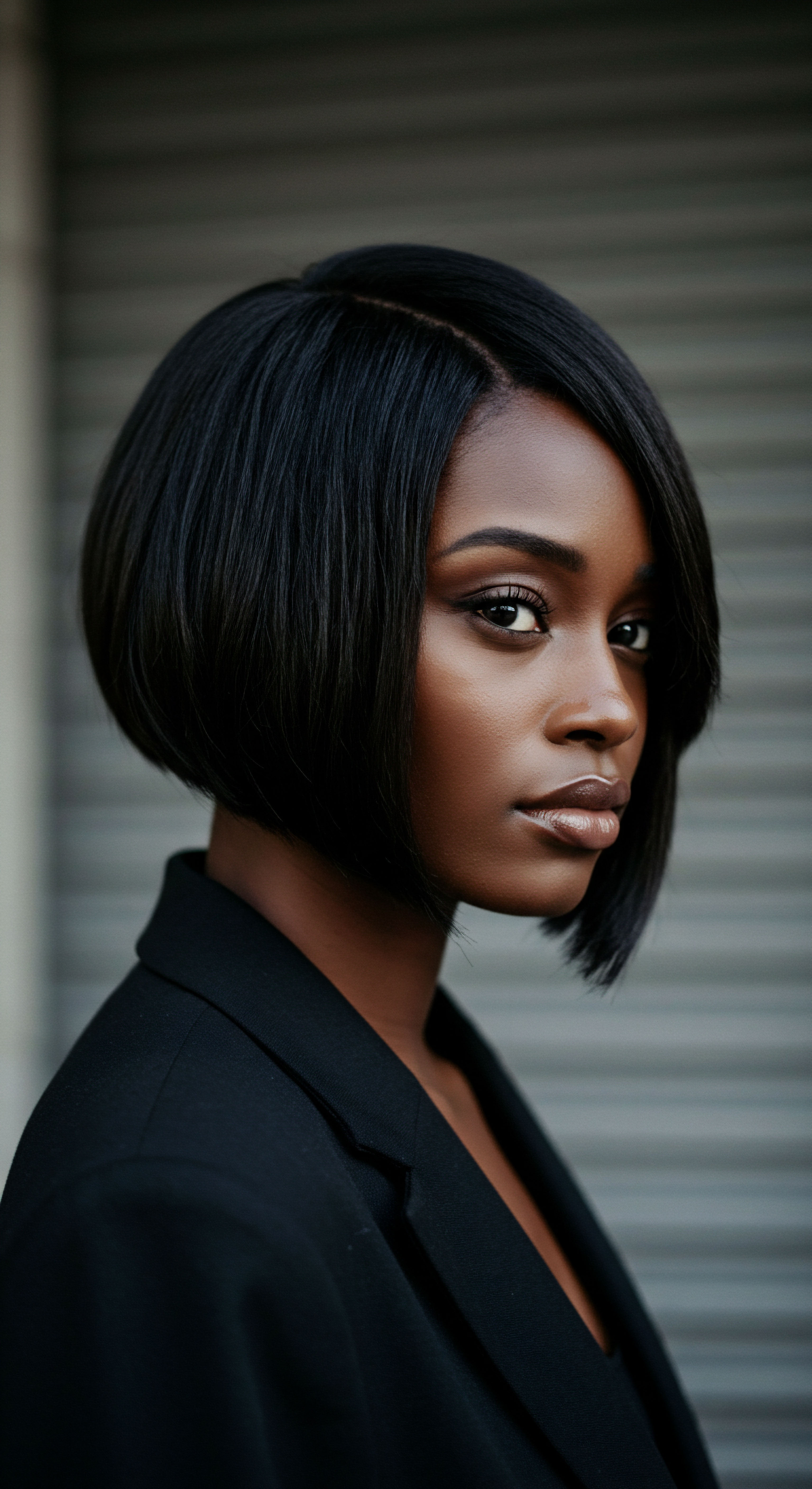
What Cultural Narratives Do Bonnets Carry?
Bonnets, within the Black community, are not merely functional items; they are storytellers. They carry narratives of adaptability, of turning constraint into creativity. During periods of enslavement and subsequent discrimination, head coverings became a means of coded communication and quiet resistance.
For instance, in Suriname, enslaved Black women used specific tying styles of their headscarves to send messages to one another, navigating oppressive environments where open communication was forbidden. This historical ingenuity is a foundational narrative carried within the very concept of the head covering.
Beyond resistance, bonnets embody a narrative of care and generational wisdom. They represent the lessons passed down through families about preserving hair, about respecting its texture, and about the importance of nightly rituals. The shared experience of seeing mothers, grandmothers, and aunties don their bonnets before bed creates a cultural memory, linking present practices to ancestral traditions. This quiet ritual speaks to a deep, communal understanding of hair as a valued part of one’s being, deserving of consistent protection.
Consider the broader implications for hair loss and societal pressures. Studies indicate that a significant portion of women report that a “bad hair day” negatively impacts their self-esteem. For Black women, who historically faced, and continue to face, discrimination based on their natural hair in professional and educational settings, the psychological burden can be immense. The CROWN Act, passed in California in 2019, made it illegal to discriminate in workplaces and schools based on natural hair, a legislative recognition of this persistent issue.
In this context, the bonnet contributes to a counter-narrative ❉ one of self-acceptance and resilience. By helping to maintain healthy hair, bonnets indirectly support mental well-being by alleviating some of the stress associated with societal hair expectations. They allow for a deeper connection to natural hair, which in turn supports a healthier self-perception and a more confident presentation of one’s authentic self in the world.
The cultural significance of bonnets is thus a complex interplay of historical adversity, ingenious adaptation, communal knowledge, and individual self-affirmation. They stand as a quiet symbol of enduring spirit and beauty.
- Historical Roots ❉ Head coverings transformed from markers of status in Africa to symbols of forced subservience, then reclaimed as acts of resistance.
- Psychological Well-Being ❉ Bonnets support self-acceptance by preserving natural hair, reducing reliance on damaging alterations, and countering societal pressures.
- Communal Identity ❉ The shared practice of wearing bonnets reinforces cultural connection and transmits generational knowledge of hair care.
| Historical Period/Context Pre-Colonial Africa |
| Primary Significance Status, spirituality, beauty, marital standing. |
| Impact on Identity Affirmation of cultural identity and social role. |
| Historical Period/Context Slavery/Colonial Era |
| Primary Significance Forced subservience, control, but also coded communication. |
| Impact on Identity Resistance, silent defiance, preservation of heritage. |
| Historical Period/Context Post-Slavery/Early 20th Century |
| Primary Significance Association with domesticity, necessity for protective styling. |
| Impact on Identity Adaptation to new social realities, continued practical use. |
| Historical Period/Context Civil Rights Era/Natural Hair Movement |
| Primary Significance Symbol of Black pride, self-acceptance, political statement. |
| Impact on Identity Reclamation of cultural heritage, assertion of autonomy. |
| Historical Period/Context Contemporary Usage |
| Primary Significance Hair health, self-care, fashion, cultural connection. |
| Impact on Identity Personal expression, community building, legacy of resilience. |
| Historical Period/Context Head coverings have consistently served as powerful markers of identity and cultural resilience across generations. |
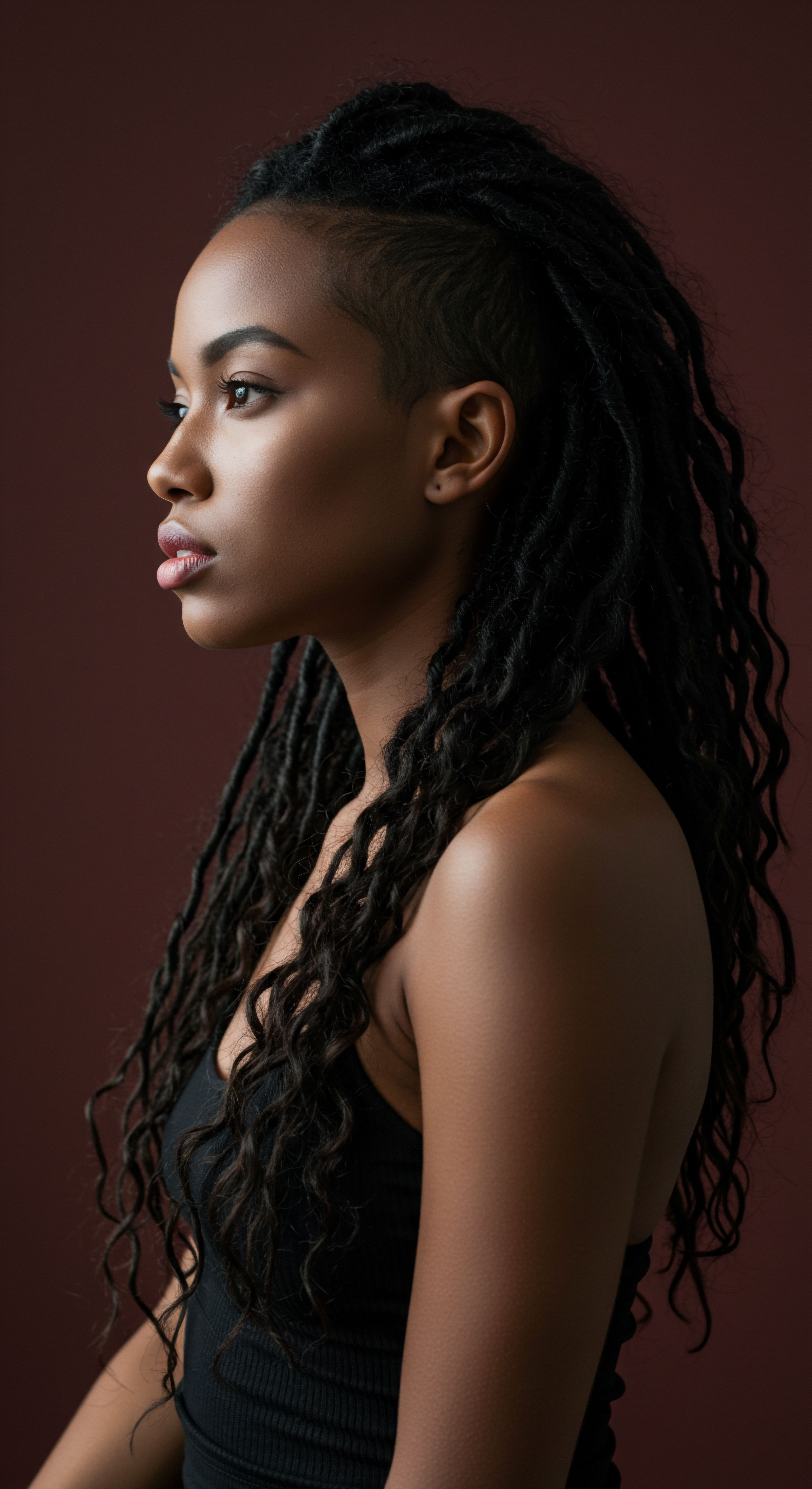
Reflection
The journey through the world of bonnets reveals more than just a simple accessory; it uncovers a rich narrative of care, resilience, and identity. From the delicate science of hair fiber to the profound echoes of cultural heritage, the bonnet stands as a testament to thoughtful practice and enduring spirit. It reminds us that sometimes, the most unassuming objects carry the deepest meanings, quietly safeguarding both our physical strands and the stories woven within them.

References
- Byrd, A. D. & Tharps, L. D. (2014). Hair Story ❉ Untangling the Roots of Black Hair in America. St. Martin’s Griffin.
- Ashby, S. P. (2016). Archaeologies of Hair ❉ An Introduction. Internet Archaeology, 42.
- Malinauskyte, E. Kang, X. & Gabarra, M. (2023). The Fabric Factor ❉ The Role of Your Pillowcase and Hair Accessories in Hair Care. TRI Princeton.
- Delaney, C. (1994). Untangling the Meanings of Hair in Turkish Society. Anthropological Quarterly, 67(4), 159-172.
- Mercer, K. (2000). Black Hair/Style Politics. In M. G. Steedman (Ed.), The Feminism and Visual Culture Reader (pp. 352-364). Routledge.
- Moore, J. (2014). The Sociology of Hair ❉ Hair Symbolism Among College Students. Social Sciences Journal, 10, 35-48.
- Rodriguez, A. (2003). Hair ❉ The Story of African Hair in America. St. Martin’s Press.
- Thompson, C. (2009). Madam C. J. Walker ❉ Entrepreneur. Chelsea House.
- Marks, D. H. Penzi, L. R. Ibler, E. & Manatis-Lornell, A. (2020). Psychological Impact of Alopecia Areata. Dermatology Research and Practice, 2020.
- Okazawa-Rey, M. et al. (1987). African Hair ❉ A Sociological and Historical Overview. Sage Publications.
- Johnson, K. (2013). African American Hair ❉ A History of Style, Culture, and Beauty. University Press of Mississippi.
- Green, T. (2016). “Ugly” and “Unprofessional” ❉ Black Women’s Experiences of Hair Discrimination in the Workplace. Journal of Critical Race Inquiry, 3(1).
- Clarke-Jeffers, M. (2022). Hair and Mental Health ❉ A Black Woman’s Perspective. International Journal of Mental Health Nursing, 31(2).
- Byrd, A. D. & Tharps, L. D. (2014). Hair Story ❉ Untangling the Roots of Black Hair in America. St. Martin’s Griffin.
- Donahoo, M. (2019). Hair Politics ❉ Black Women, Beauty, and Resistance. University of Illinois Press.